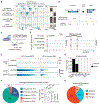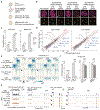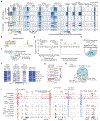Systematic evaluation of retroviral LTRs as cis-regulatory elements in mouse embryos
- PMID: 38381606
- PMCID: PMC11024894
- DOI: 10.1016/j.celrep.2024.113775
Systematic evaluation of retroviral LTRs as cis-regulatory elements in mouse embryos
Abstract
In mammals, many retrotransposons are de-repressed during zygotic genome activation (ZGA). However, their functions in early development remain elusive largely due to the challenge to simultaneously manipulate thousands of retrotransposon insertions in embryos. Here, we applied CRISPR interference (CRISPRi) to perturb the long terminal repeat (LTR) MT2_Mm, a well-known ZGA and totipotency marker that exists in ∼2,667 insertions throughout the mouse genome. CRISPRi robustly perturbed 2,485 (∼93%) MT2_Mm insertions and 1,090 (∼55%) insertions of the closely related MT2C_Mm in 2-cell embryos. Remarkably, such perturbation caused downregulation of hundreds of ZGA genes and embryonic arrest mostly at the morula stage. Mechanistically, MT2 LTRs are globally enriched for open chromatin and H3K27ac and function as promoters/enhancers downstream of OBOX/DUX proteins. Thus, we not only provide direct evidence to support the functional importance of MT2 activation in development but also systematically define cis-regulatory function of MT2 in embryos by integrating functional perturbation and multi-omic analyses.
Keywords: CP: Developmental biology; MERVL; MT2C_mm; MT2_mm; endogenous retroviruses; epigenome editing; long terminal repeats; preimplantation embryos; zygotic genome activation.
Copyright © 2024 The Author(s). Published by Elsevier Inc. All rights reserved.
Conflict of interest statement
Declaration of interests The authors declare no competing financial interests.
Figures




Update of
-
Systematic Perturbation of Thousands of Retroviral LTRs in Mouse Embryos.bioRxiv [Preprint]. 2023 Sep 20:2023.09.19.558531. doi: 10.1101/2023.09.19.558531. bioRxiv. 2023. Update in: Cell Rep. 2024 Mar 26;43(3):113775. doi: 10.1016/j.celrep.2024.113775. PMID: 37781606 Free PMC article. Updated. Preprint.
Similar articles
-
Systematic Perturbation of Thousands of Retroviral LTRs in Mouse Embryos.bioRxiv [Preprint]. 2023 Sep 20:2023.09.19.558531. doi: 10.1101/2023.09.19.558531. bioRxiv. 2023. Update in: Cell Rep. 2024 Mar 26;43(3):113775. doi: 10.1016/j.celrep.2024.113775. PMID: 37781606 Free PMC article. Updated. Preprint.
-
Transcription of MERVL retrotransposons is required for preimplantation embryo development.Nat Genet. 2023 Mar;55(3):484-495. doi: 10.1038/s41588-023-01324-y. Epub 2023 Mar 2. Nat Genet. 2023. PMID: 36864102 Free PMC article.
-
Obox4 promotes zygotic genome activation upon loss of Dux.Elife. 2024 Jun 24;13:e95856. doi: 10.7554/eLife.95856. Elife. 2024. PMID: 38856708 Free PMC article.
-
Retrotransposon renaissance in early embryos.Trends Genet. 2024 Jan;40(1):39-51. doi: 10.1016/j.tig.2023.10.010. Epub 2023 Nov 8. Trends Genet. 2024. PMID: 37949723 Free PMC article. Review.
-
The impact of retrotransposons on zygotic genome activation and the chromatin landscape of early embryos.Ann N Y Acad Sci. 2024 Dec;1542(1):11-24. doi: 10.1111/nyas.15260. Epub 2024 Nov 22. Ann N Y Acad Sci. 2024. PMID: 39576233 Free PMC article. Review.
Cited by
-
Rise and SINE: roles of transcription factors and retrotransposons in zygotic genome activation.Nat Rev Mol Cell Biol. 2025 Jan;26(1):68-79. doi: 10.1038/s41580-024-00772-6. Epub 2024 Oct 2. Nat Rev Mol Cell Biol. 2025. PMID: 39358607
-
Polycomb Repressive-Deubiquitinase Complex Safeguards Oocyte Epigenome and Female Fertility by Restraining Polycomb Activity.bioRxiv [Preprint]. 2025 Jul 28:2025.07.24.666633. doi: 10.1101/2025.07.24.666633. bioRxiv. 2025. PMID: 40766345 Free PMC article. Preprint.
-
Endogenous retroviruses mediate transcriptional rewiring in response to oncogenic signaling in colorectal cancer.Sci Adv. 2024 Jul 19;10(29):eado1218. doi: 10.1126/sciadv.ado1218. Epub 2024 Jul 17. Sci Adv. 2024. PMID: 39018396 Free PMC article.
-
The maternal-to-zygotic transition: reprogramming of the cytoplasm and nucleus.Nat Rev Genet. 2025 Apr;26(4):245-267. doi: 10.1038/s41576-024-00792-0. Epub 2024 Nov 25. Nat Rev Genet. 2025. PMID: 39587307 Free PMC article. Review.
-
USP17L promotes the 2-cell-like program through deubiquitination of H2AK119ub1 and ZSCAN4.Nat Commun. 2025 Aug 1;16(1):7071. doi: 10.1038/s41467-025-62303-x. Nat Commun. 2025. PMID: 40750602 Free PMC article.
References
MeSH terms
Substances
Grants and funding
LinkOut - more resources
Full Text Sources
Molecular Biology Databases
Miscellaneous

